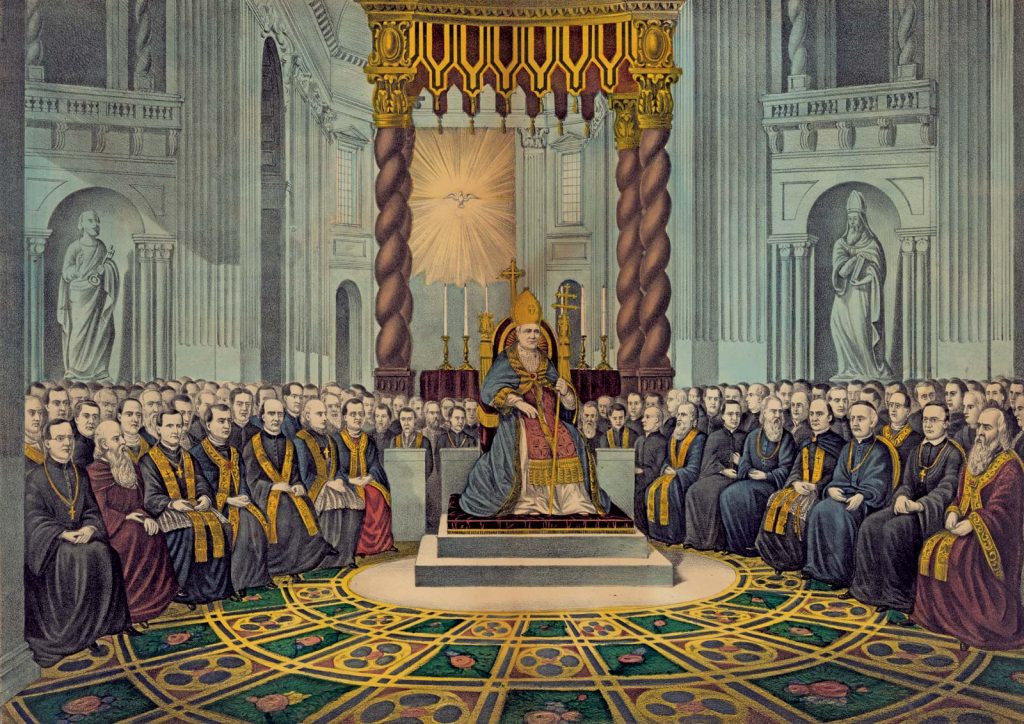Not Synods: Vatican Councils and Bishops’ Conferences
Last week I wrote about the German synod and women. This week I want to write about synods more generally, inspired by Massimo Faggioli’s article in La Croix International, “Synodality and the abuse crisis: The Church is still stuck in Trent.” But he begins by writing about the First Vatican Council convened in 1869, which “paved the way for a ‘period of certainty.’”

Library of Congress, Washington, D.C. (LC-DIG-pga-03306)
The sex abuse crisis, Faggioli then argues, “shattered any such allusions [illusions?] of supposed certitude” and led to “a period of paralyzing uncertainty, something much different from the liberating uncertainty that marked the initial years after the Second Vatican Council.” I love that idea because I lived it: the suddenly open windows of John XXIII! But the aftermath is much less lovable:
The sobering fact is that the failure of the post-Vatican II period to tackle those horrific crimes is nothing new. If we look back to the council of Trent (1545-1563), we can see there was also a disconnect between its teaching on reform and how it was applied to the real life of the Church.
Post-Trent was a time when clerics were rarely “accused of criminal acts (especially sexual crimes)” because of the Vatican’s interest in establishing its authority and “keeping the power of the state at bay.” These crimes were kept in the ecclesial justice system where secrecy prevailed. It occurs to me that the supposed certainty of post-Trent was anything but; when it came to church politics, Faggioli says that all sorts of actors – “the papacy and its diplomats, the bishops, the religious orders, and lay Catholic elites” – struggled with each other for supremacy. And by the 18th century secular authorities moved to intervene to prosecute clergy crimes.
Of course, that is replicated today. No government will tolerate this misbehavior; the Catholic laity will not, either.
Faggioli gets to his main point by considering the change in ecclesiology from Trent to Vatican II. “Catholics have a theological idea about the Church that is no longer dominated by elites and hierarchies.” That idea: The Church is the People of God. This belief, however, is not yet reflected in church structure. Synodality, Faggioli argues, is the way to go, quoting Francis:
in a major speech in October 2015 – it addresses the evil that “consigns the fate of entire peoples to the grasp of small but powerful groups.”
That papal speech on synodality marked a key moment in the history of the reception of Vatican II. And it should also mark a point of passage in how the Church must face the abuse crisis. …
The alternative is to passively stand by, in shame and disgust, as the news cycles trumpet the sordid activities of this or that prelate and publish the latest devastating report by a grand jury or attorney general. …
The refusal to consider synodality as a key part of the Church’s response to the abuse crisis is a failure of ecclesial imagination. It is also a betrayal of the People of God.
In contrast, Faggioli finds great hope in a few local or national synods, which all have created policies to address sexual abuse. But so have the United States Conference of Catholic Bishops (USCCB). What’s the difference?
In his speech about synods, Francis gently summarizes the actions of his predecessors from Paul VI to Benedict XVI to “further improve” synods, as John Paul II wrote, and goes on to write about “what God expects of the Church of the third millennium.” Francis endorses “the supernatural sense of the faith (sensus fidei) of the whole people of God,” and goes on to say “The sensus fidei prevents a rigid separation between an Ecclesia docens and an Ecclesia discens, since the flock likewise has an instinctive ability to discern the new ways that the Lord is revealing to the Church.” Do you get the Latin? I assume it’s the teaching and the learning church. We flock are to discern the new ways. WOC always has; I will remind you that WOC has always been articulating the Gospel “signs of the times.”
“A synodal Church is a Church which listens, which realizes that listening ‘is more than simply hearing.’(12) It is a mutual listening in which everyone has something to learn,” Francis says. He goes on two describe two essentially contradictory structures; one, a process that goes up the hierarchy from the laity to the pope. Then he describes this as an “inverted pyramid,” in which “the top is located beneath the base” and the pope is the “servus servorum Dei,” servant of the servants of God, an image I have loved from the first moment I heard it as a teenager. But if the servus finally calls all the shots in such a complex institution, how effective can the base be?
Would that we could have a synodal Church in which “participation, solidarity and transparency in public administration” are the hallmarks, not one that “consigns the fate of entire peoples to the grasp of small but powerful groups.” Francis presents this synodal Church as a model for the whole world; I would be happy if it were a model for the USCCB.
Faggioli writes about their recent meeting in Baltimore: “The church is no longer torn between the old monarchical model and the modern democratic model; now, it’s split over living synodally in real places with real people, and adherence to a media and communications model meant to help preserve the status quo.” He finds little theological understanding of what Francis expects synods to be.
Let us keep our eye on the ideal. Let us watch what happens in Germany in the next year to see how close that synod comes to the model Francis presents. The women of Maria 2.0 will lead the way.
